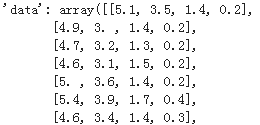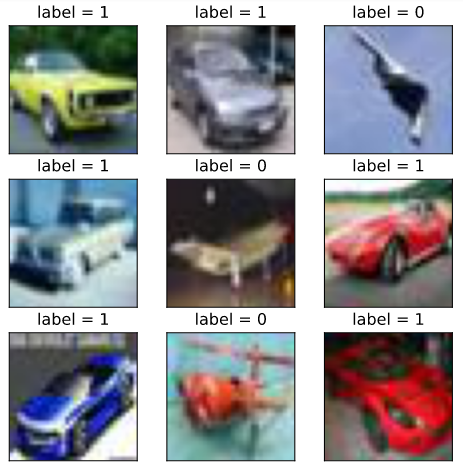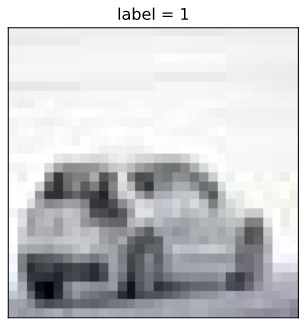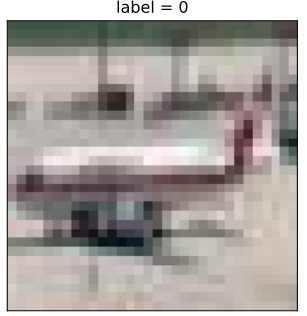【tensorflow2.0】数据管道dataset
如果需要训练的数据大小不大,例如不到1G,那么可以直接全部读入内存中进行训练,这样一般效率最高。
但如果需要训练的数据很大,例如超过10G,无法一次载入内存,那么通常需要在训练的过程中分批逐渐读入。
使用 tf.data API 可以构建数据输入管道,轻松处理大量的数据,不同的数据格式,以及不同的数据转换。
一,构建数据管道
可以从 Numpy array, Pandas DataFrame, Python generator, csv文件, 文本文件, 文件路径, tfrecords文件等方式构建数据管道。
其中通过Numpy array, Pandas DataFrame, 文件路径构建数据管道是最常用的方法。
通过tfrecords文件方式构建数据管道较为复杂,需要对样本构建tf.Example后压缩成字符串写到tfrecoreds文件,读取后再解析成tf.Example。
但tfrecoreds文件的优点是压缩后文件较小,便于网络传播,加载速度较快。
首先看下iris部分数据:

'feature_names': ['sepal length (cm)',
'sepal width (cm)',
'petal length (cm)',
'petal width (cm)'],
'filename': '/usr/local/lib/python3.6/dist-packages/sklearn/datasets/data/iris.csv',
'target': array([0, 0, 0, 0, 0, 0, 0, 0, 0, 0, 0, 0, 0, 0, 0, 0, 0, 0, 0, 0, 0, 0,
0, 0, 0, 0, 0, 0, 0, 0, 0, 0, 0, 0, 0, 0, 0, 0, 0, 0, 0, 0, 0, 0,
0, 0, 0, 0, 0, 0, 1, 1, 1, 1, 1, 1, 1, 1, 1, 1, 1, 1, 1, 1, 1, 1,
1, 1, 1, 1, 1, 1, 1, 1, 1, 1, 1, 1, 1, 1, 1, 1, 1, 1, 1, 1, 1, 1,
1, 1, 1, 1, 1, 1, 1, 1, 1, 1, 1, 1, 2, 2, 2, 2, 2, 2, 2, 2, 2, 2,
2, 2, 2, 2, 2, 2, 2, 2, 2, 2, 2, 2, 2, 2, 2, 2, 2, 2, 2, 2, 2, 2,
2, 2, 2, 2, 2, 2, 2, 2, 2, 2, 2, 2, 2, 2, 2, 2, 2, 2]),
'target_names': array(['setosa', 'versicolor', 'virginica'], dtype='<U10')
1,从Numpy array构建数据管道
# 从Numpy array构建数据管道 import tensorflow as tf
import numpy as np
from sklearn import datasets
iris = datasets.load_iris() ds1 = tf.data.Dataset.from_tensor_slices((iris["data"],iris["target"]))
for features,label in ds1.take(5):
print(features,label)
tf.Tensor([5.1 3.5 1.4 0.2], shape=(4,), dtype=float64) tf.Tensor(0, shape=(), dtype=int64)
tf.Tensor([4.9 3. 1.4 0.2], shape=(4,), dtype=float64) tf.Tensor(0, shape=(), dtype=int64)
tf.Tensor([4.7 3.2 1.3 0.2], shape=(4,), dtype=float64) tf.Tensor(0, shape=(), dtype=int64)
tf.Tensor([4.6 3.1 1.5 0.2], shape=(4,), dtype=float64) tf.Tensor(0, shape=(), dtype=int64)
tf.Tensor([5. 3.6 1.4 0.2], shape=(4,), dtype=float64) tf.Tensor(0, shape=(), dtype=int642,从 Pandas DataFrame构建数据管道
# 从 Pandas DataFrame构建数据管道
import tensorflow as tf
from sklearn import datasets
import pandas as pd
iris = datasets.load_iris()
dfiris = pd.DataFrame(iris["data"],columns = iris.feature_names)
ds2 = tf.data.Dataset.from_tensor_slices((dfiris.to_dict("list"),iris["target"])) for features,label in ds2.take(3):
print(features,label)
{'sepal length (cm)': <tf.Tensor: shape=(), dtype=float32, numpy=5.1>, 'sepal width (cm)': <tf.Tensor: shape=(), dtype=float32, numpy=3.5>, 'petal length (cm)': <tf.Tensor: shape=(), dtype=float32, numpy=1.4>, 'petal width (cm)': <tf.Tensor: shape=(), dtype=float32, numpy=0.2>} tf.Tensor(0, shape=(), dtype=int64)
{'sepal length (cm)': <tf.Tensor: shape=(), dtype=float32, numpy=4.9>, 'sepal width (cm)': <tf.Tensor: shape=(), dtype=float32, numpy=3.0>, 'petal length (cm)': <tf.Tensor: shape=(), dtype=float32, numpy=1.4>, 'petal width (cm)': <tf.Tensor: shape=(), dtype=float32, numpy=0.2>} tf.Tensor(0, shape=(), dtype=int64)
{'sepal length (cm)': <tf.Tensor: shape=(), dtype=float32, numpy=4.7>, 'sepal width (cm)': <tf.Tensor: shape=(), dtype=float32, numpy=3.2>, 'petal length (cm)': <tf.Tensor: shape=(), dtype=float32, numpy=1.3>, 'petal width (cm)': <tf.Tensor: shape=(), dtype=float32, numpy=0.2>} tf.Tensor(0, shape=(), dtype=int64)3,从Python generator构建数据管道
# 从Python generator构建数据管道
import tensorflow as tf
from matplotlib import pyplot as plt
from tensorflow.keras.preprocessing.image import ImageDataGenerator # 定义一个从文件中读取图片的generator
image_generator = ImageDataGenerator(rescale=1.0/255).flow_from_directory(
"./data/cifar2/test/",
target_size=(32, 32),
batch_size=20,
class_mode='binary') classdict = image_generator.class_indices
print(classdict)
Found 2000 images
belonging to 2 classes. {'airplane': 0, 'automobile': 1}
def generator():
for features,label in image_generator:
yield (features,label) ds3 = tf.data.Dataset.from_generator(generator,output_types=(tf.float32,tf.int32))
%matplotlib inline
%config InlineBackend.figure_format = 'svg'
plt.figure(figsize=(6,6))
for i,(img,label) in enumerate(ds3.unbatch().take(9)):
ax=plt.subplot(3,3,i+1)
ax.imshow(img.numpy())
ax.set_title("label = %d"%label)
ax.set_xticks([])
ax.set_yticks([])
plt.show()

4,从csv文件构建数据管道
# 从csv文件构建数据管道
ds4 = tf.data.experimental.make_csv_dataset(
file_pattern = ["./data/titanic/train.csv","./data/titanic/test.csv"],
batch_size=3,
label_name="Survived",
na_value="",
num_epochs=1,
ignore_errors=True) for data,label in ds4.take(2):
print(data,label)
OrderedDict([('PassengerId', <tf.Tensor: shape=(3,), dtype=int32, numpy=array([540, 58, 764], dtype=int32)>), ('Pclass', <tf.Tensor: shape=(3,), dtype=int32, numpy=array([1, 3, 1], dtype=int32)>), ('Name', <tf.Tensor: shape=(3,), dtype=string, numpy=
array([b'Frolicher, Miss. Hedwig Margaritha', b'Novel, Mr. Mansouer',
b'Carter, Mrs. William Ernest (Lucile Polk)'], dtype=object)>), ('Sex', <tf.Tensor: shape=(3,), dtype=string, numpy=array([b'female', b'male', b'female'], dtype=object)>), ('Age', <tf.Tensor: shape=(3,), dtype=float32, numpy=array([22. , 28.5, 36. ], dtype=float32)>), ('SibSp', <tf.Tensor: shape=(3,), dtype=int32, numpy=array([0, 0, 1], dtype=int32)>), ('Parch', <tf.Tensor: shape=(3,), dtype=int32, numpy=array([2, 0, 2], dtype=int32)>), ('Ticket', <tf.Tensor: shape=(3,), dtype=string, numpy=array([b'13568', b'2697', b'113760'], dtype=object)>), ('Fare', <tf.Tensor: shape=(3,), dtype=float32, numpy=array([ 49.5 , 7.2292, 120. ], dtype=float32)>), ('Cabin', <tf.Tensor: shape=(3,), dtype=string, numpy=array([b'B39', b'', b'B96 B98'], dtype=object)>), ('Embarked', <tf.Tensor: shape=(3,), dtype=string, numpy=array([b'C', b'C', b'S'], dtype=object)>)]) tf.Tensor([1 0 1], shape=(3,), dtype=int32)
OrderedDict([('PassengerId', <tf.Tensor: shape=(3,), dtype=int32, numpy=array([845, 66, 390], dtype=int32)>), ('Pclass', <tf.Tensor: shape=(3,), dtype=int32, numpy=array([3, 3, 2], dtype=int32)>), ('Name', <tf.Tensor: shape=(3,), dtype=string, numpy=
array([b'Culumovic, Mr. Jeso', b'Moubarek, Master. Gerios',
b'Lehmann, Miss. Bertha'], dtype=object)>), ('Sex', <tf.Tensor: shape=(3,), dtype=string, numpy=array([b'male', b'male', b'female'], dtype=object)>), ('Age', <tf.Tensor: shape=(3,), dtype=float32, numpy=array([17., 0., 17.], dtype=float32)>), ('SibSp', <tf.Tensor: shape=(3,), dtype=int32, numpy=array([0, 1, 0], dtype=int32)>), ('Parch', <tf.Tensor: shape=(3,), dtype=int32, numpy=array([0, 1, 0], dtype=int32)>), ('Ticket', <tf.Tensor: shape=(3,), dtype=string, numpy=array([b'315090', b'2661', b'SC 1748'], dtype=object)>), ('Fare', <tf.Tensor: shape=(3,), dtype=float32, numpy=array([ 8.6625, 15.2458, 12. ], dtype=float32)>), ('Cabin', <tf.Tensor: shape=(3,), dtype=string, numpy=array([b'', b'', b''], dtype=object)>), ('Embarked', <tf.Tensor: shape=(3,), dtype=string, numpy=array([b'S', b'C', b'C'], dtype=object)>)]) tf.Tensor([0 1 1], shape=(3,), dtype=int32)5,从文本文件构建数据管道
# 从文本文件构建数据管道 ds5 = tf.data.TextLineDataset(
filenames = ["./data/titanic/train.csv","./data/titanic/test.csv"]
).skip(1) #略去第一行header for line in ds5.take(5):
print(line)
tf.Tensor(b'493,0,1,"Molson, Mr. Harry Markland",male,55.0,0,0,113787,30.5,C30,S', shape=(), dtype=string)
tf.Tensor(b'53,1,1,"Harper, Mrs. Henry Sleeper (Myna Haxtun)",female,49.0,1,0,PC 17572,76.7292,D33,C', shape=(), dtype=string)
tf.Tensor(b'388,1,2,"Buss, Miss. Kate",female,36.0,0,0,27849,13.0,,S', shape=(), dtype=string)
tf.Tensor(b'192,0,2,"Carbines, Mr. William",male,19.0,0,0,28424,13.0,,S', shape=(), dtype=string)
tf.Tensor(b'687,0,3,"Panula, Mr. Jaako Arnold",male,14.0,4,1,3101295,39.6875,,S', shape=(), dtype=string)6,从文件路径构建数据管道
s6 = tf.data.Dataset.list_files("./data/cifar2/train/*/*.jpg")
for file in ds6.take(5):
print(file)
tf.Tensor(b'./data/cifar2/train/automobile/1263.jpg', shape=(), dtype=string)
tf.Tensor(b'./data/cifar2/train/airplane/2837.jpg', shape=(), dtype=string)
tf.Tensor(b'./data/cifar2/train/airplane/4264.jpg', shape=(), dtype=string)
tf.Tensor(b'./data/cifar2/train/automobile/4241.jpg', shape=(), dtype=string)
tf.Tensor(b'./data/cifar2/train/automobile/192.jpg', shape=(), dtype=string)from matplotlib import pyplot as plt
def load_image(img_path,size = (32,32)):
label = 1 if tf.strings.regex_full_match(img_path,".*/automobile/.*") else 0
img = tf.io.read_file(img_path)
img = tf.image.decode_jpeg(img) #注意此处为jpeg格式
img = tf.image.resize(img,size)
return(img,label) %matplotlib inline
%config InlineBackend.figure_format = 'svg'
for i,(img,label) in enumerate(ds6.map(load_image).take(2)):
plt.figure(i)
plt.imshow((img/255.0).numpy())
plt.title("label = %d"%label)
plt.xticks([])
plt.yticks([])


7,从tfrecords文件构建数据管道
import os
import numpy as np # inpath:原始数据路径 outpath:TFRecord文件输出路径
def create_tfrecords(inpath,outpath):
writer = tf.io.TFRecordWriter(outpath)
dirs = os.listdir(inpath)
for index, name in enumerate(dirs):
class_path = inpath +"/"+ name+"/"
for img_name in os.listdir(class_path):
img_path = class_path + img_name
img = tf.io.read_file(img_path)
#img = tf.image.decode_image(img)
#img = tf.image.encode_jpeg(img) #统一成jpeg格式压缩
example = tf.train.Example(
features=tf.train.Features(feature={
'label': tf.train.Feature(int64_list=tf.train.Int64List(value=[index])),
'img_raw': tf.train.Feature(bytes_list=tf.train.BytesList(value=[img.numpy()]))
}))
writer.write(example.SerializeToString())
writer.close() create_tfrecords("./data/cifar2/test/","./data/cifar2_test.tfrecords/") from matplotlib import pyplot as plt def parse_example(proto):
description ={ 'img_raw' : tf.io.FixedLenFeature([], tf.string),
'label': tf.io.FixedLenFeature([], tf.int64)}
example = tf.io.parse_single_example(proto, description)
img = tf.image.decode_jpeg(example["img_raw"]) #注意此处为jpeg格式
img = tf.image.resize(img, (32,32))
label = example["label"]
return(img,label) ds7 = tf.data.TFRecordDataset("./data/cifar2_test.tfrecords").map(parse_example).shuffle(3000) %matplotlib inline
%config InlineBackend.figure_format = 'svg'
plt.figure(figsize=(6,6))
for i,(img,label) in enumerate(ds7.take(9)):
ax=plt.subplot(3,3,i+1)
ax.imshow((img/255.0).numpy())
ax.set_title("label = %d"%label)
ax.set_xticks([])
ax.set_yticks([])
plt.show()

二,应用数据转换
Dataset数据结构应用非常灵活,因为它本质上是一个Sequece序列,其每个元素可以是各种类型,例如可以是张量,列表,字典,也可以是Dataset。
Dataset包含了非常丰富的数据转换功能。
map: 将转换函数映射到数据集每一个元素。
flat_map: 将转换函数映射到数据集的每一个元素,并将嵌套的Dataset压平。
interleave: 效果类似flat_map,但可以将不同来源的数据夹在一起。
filter: 过滤掉某些元素。
zip: 将两个长度相同的Dataset横向铰合。
concatenate: 将两个Dataset纵向连接。
reduce: 执行归并操作。
batch : 构建批次,每次放一个批次。比原始数据增加一个维度。 其逆操作为unbatch。
padded_batch: 构建批次,类似batch, 但可以填充到相同的形状。
window :构建滑动窗口,返回Dataset of Dataset.
shuffle: 数据顺序洗牌。
repeat: 重复数据若干次,不带参数时,重复无数次。
shard: 采样,从某个位置开始隔固定距离采样一个元素。
- take: 采样,从开始位置取前几个元素。
# map:将转换函数映射到数据集每一个元素 ds = tf.data.Dataset.from_tensor_slices(["hello world","hello China","hello Beijing"])
ds_map = ds.map(lambda x:tf.strings.split(x," "))
for x in ds_map:
print(x)
tf.Tensor([b'hello' b'world'], shape=(2,), dtype=string)
tf.Tensor([b'hello' b'China'], shape=(2,), dtype=string)
tf.Tensor([b'hello' b'Beijing'], shape=(2,), dtype=string)# flat_map:将转换函数映射到数据集的每一个元素,并将嵌套的Dataset压平。 ds = tf.data.Dataset.from_tensor_slices(["hello world","hello China","hello Beijing"])
ds_flatmap = ds.flat_map(lambda x:tf.data.Dataset.from_tensor_slices(tf.strings.split(x," ")))
for x in ds_flatmap:
print(x)
tf.Tensor(b'hello', shape=(), dtype=string)
tf.Tensor(b'world', shape=(), dtype=string)
tf.Tensor(b'hello', shape=(), dtype=string)
tf.Tensor(b'China', shape=(), dtype=string)
tf.Tensor(b'hello', shape=(), dtype=string)
tf.Tensor(b'Beijing', shape=(), dtype=string)# interleave: 效果类似flat_map,但可以将不同来源的数据夹在一起。 ds = tf.data.Dataset.from_tensor_slices(["hello world","hello China","hello Beijing"])
ds_interleave = ds.interleave(lambda x:tf.data.Dataset.from_tensor_slices(tf.strings.split(x," ")))
for x in ds_interleave:
print(x)
tf.Tensor(b'hello', shape=(), dtype=string)
tf.Tensor(b'hello', shape=(), dtype=string)
tf.Tensor(b'hello', shape=(), dtype=string)
tf.Tensor(b'world', shape=(), dtype=string)
tf.Tensor(b'China', shape=(), dtype=string)
tf.Tensor(b'Beijing', shape=(), dtype=string)# filter:过滤掉某些元素。 ds = tf.data.Dataset.from_tensor_slices(["hello world","hello China","hello Beijing"])
# 找出含有字母a或B的元素
ds_filter = ds.filter(lambda x: tf.strings.regex_full_match(x, ".*[a|B].*"))
for x in ds_filter:
print(x)
tf.Tensor(b'hello China', shape=(), dtype=string)
tf.Tensor(b'hello Beijing', shape=(), dtype=string)# zip:将两个长度相同的Dataset横向铰合。 ds1 = tf.data.Dataset.range(0,3)
ds2 = tf.data.Dataset.range(3,6)
ds3 = tf.data.Dataset.range(6,9)
ds_zip = tf.data.Dataset.zip((ds1,ds2,ds3))
for x,y,z in ds_zip:
print(x.numpy(),y.numpy(),z.numpy())
0 3 6
1 4 7
2 5 8# condatenate:将两个Dataset纵向连接。 ds1 = tf.data.Dataset.range(0,3)
ds2 = tf.data.Dataset.range(3,6)
ds_concat = tf.data.Dataset.concatenate(ds1,ds2)
for x in ds_concat:
print(x)
tf.Tensor(0, shape=(), dtype=int64)
tf.Tensor(1, shape=(), dtype=int64)
tf.Tensor(2, shape=(), dtype=int64)
tf.Tensor(3, shape=(), dtype=int64)
tf.Tensor(4, shape=(), dtype=int64)
tf.Tensor(5, shape=(), dtype=int64)# reduce:执行归并操作。 ds = tf.data.Dataset.from_tensor_slices([1,2,3,4,5.0])
result = ds.reduce(0.0,lambda x,y:tf.add(x,y))
result
<tf.Tensor: shape=(), dtype=float32, numpy=15.0># batch:构建批次,每次放一个批次。比原始数据增加一个维度。 其逆操作为unbatch。 ds = tf.data.Dataset.range(12)
ds_batch = ds.batch(4)
for x in ds_batch:
print(x)
tf.Tensor([0 1 2 3], shape=(4,), dtype=int64)
tf.Tensor([4 5 6 7], shape=(4,), dtype=int64)
tf.Tensor([ 8 9 10 11], shape=(4,), dtype=int64)# padded_batch:构建批次,类似batch, 但可以填充到相同的形状。 elements = [[1, 2],[3, 4, 5],[6, 7],[8]]
ds = tf.data.Dataset.from_generator(lambda: iter(elements), tf.int32) ds_padded_batch = ds.padded_batch(2,padded_shapes = [4,])
for x in ds_padded_batch:
print(x)
tf.Tensor(
[[1 2 0 0]
[3 4 5 0]], shape=(2, 4), dtype=int32)
tf.Tensor(
[[6 7 0 0]
[8 0 0 0]], shape=(2, 4), dtype=int32)# window:构建滑动窗口,返回Dataset of Dataset. ds = tf.data.Dataset.range(12)
# window返回的是Dataset of Dataset,可以用flat_map压平
ds_window = ds.window(3, shift=1).flat_map(lambda x: x.batch(3,drop_remainder=True))
for x in ds_window:
print(x)
tf.Tensor([0 1 2], shape=(3,), dtype=int64)
tf.Tensor([1 2 3], shape=(3,), dtype=int64)
tf.Tensor([2 3 4], shape=(3,), dtype=int64)
tf.Tensor([3 4 5], shape=(3,), dtype=int64)
tf.Tensor([4 5 6], shape=(3,), dtype=int64)
tf.Tensor([5 6 7], shape=(3,), dtype=int64)
tf.Tensor([6 7 8], shape=(3,), dtype=int64)
tf.Tensor([7 8 9], shape=(3,), dtype=int64)
tf.Tensor([ 8 9 10], shape=(3,), dtype=int64)
tf.Tensor([ 9 10 11], shape=(3,), dtype=int64)# shuffle:数据顺序洗牌。 ds = tf.data.Dataset.range(12)
ds_shuffle = ds.shuffle(buffer_size = 5)
for x in ds_shuffle:
print(x)
tf.Tensor(1, shape=(), dtype=int64)
tf.Tensor(4, shape=(), dtype=int64)
tf.Tensor(0, shape=(), dtype=int64)
tf.Tensor(6, shape=(), dtype=int64)
tf.Tensor(5, shape=(), dtype=int64)
tf.Tensor(2, shape=(), dtype=int64)
tf.Tensor(7, shape=(), dtype=int64)
tf.Tensor(11, shape=(), dtype=int64)
tf.Tensor(3, shape=(), dtype=int64)
tf.Tensor(9, shape=(), dtype=int64)
tf.Tensor(10, shape=(), dtype=int64)
tf.Tensor(8, shape=(), dtype=int64)# repeat:重复数据若干次,不带参数时,重复无数次。 ds = tf.data.Dataset.range(3)
ds_repeat = ds.repeat(3)
for x in ds_repeat:
print(x)
tf.Tensor(0, shape=(), dtype=int64)
tf.Tensor(1, shape=(), dtype=int64)
tf.Tensor(2, shape=(), dtype=int64)
tf.Tensor(0, shape=(), dtype=int64)
tf.Tensor(1, shape=(), dtype=int64)
tf.Tensor(2, shape=(), dtype=int64)
tf.Tensor(0, shape=(), dtype=int64)
tf.Tensor(1, shape=(), dtype=int64)
tf.Tensor(2, shape=(), dtype=int64)# shard:采样,从某个位置开始隔固定距离采样一个元素。 ds = tf.data.Dataset.range(12)
ds_shard = ds.shard(3,index = 1) for x in ds_shard:
print(x)
tf.Tensor(1, shape=(), dtype=int64)
tf.Tensor(4, shape=(), dtype=int64)
tf.Tensor(7, shape=(), dtype=int64)
tf.Tensor(10, shape=(), dtype=int64)# take:采样,从开始位置取前几个元素。 ds = tf.data.Dataset.range(12)
ds_take = ds.take(3) list(ds_take.as_numpy_iterator())
[0, 1, 2]三,提升管道性能
训练深度学习模型常常会非常耗时。
模型训练的耗时主要来自于两个部分,一部分来自数据准备,另一部分来自参数迭代。
参数迭代过程的耗时通常依赖于GPU来提升。
而数据准备过程的耗时则可以通过构建高效的数据管道进行提升。
以下是一些构建高效数据管道的建议。
1,使用 prefetch 方法让数据准备和参数迭代两个过程相互并行。
2,使用 interleave 方法可以让数据读取过程多进程执行,并将不同来源数据夹在一起。
3,使用 map 时设置num_parallel_calls 让数据转换过程多进行执行。
4,使用 cache 方法让数据在第一个epoch后缓存到内存中,仅限于数据集不大情形。
5,使用 map转换时,先batch, 然后采用向量化的转换方法对每个batch进行转换。
1,使用 prefetch 方法让数据准备和参数迭代两个过程相互并行。
import tensorflow as tf # 打印时间分割线
@tf.function
def printbar():
ts = tf.timestamp()
today_ts = ts%(24*60*60) hour = tf.cast(today_ts//3600+8,tf.int32)%tf.constant(24)
minite = tf.cast((today_ts%3600)//60,tf.int32)
second = tf.cast(tf.floor(today_ts%60),tf.int32) def timeformat(m):
if tf.strings.length(tf.strings.format("{}",m))==1:
return(tf.strings.format("0{}",m))
else:
return(tf.strings.format("{}",m)) timestring = tf.strings.join([timeformat(hour),timeformat(minite),
timeformat(second)],separator = ":")
tf.print("=========="*8,end = "")
tf.print(timestring) import time # 数据准备和参数迭代两个过程默认情况下是串行的。 # 模拟数据准备
def generator():
for i in range(10):
#假设每次准备数据需要2s
time.sleep(2)
yield i
ds = tf.data.Dataset.from_generator(generator,output_types = (tf.int32)) # 模拟参数迭代
def train_step():
#假设每一步训练需要1s
time.sleep(1) # 训练过程预计耗时 10*2+10*1+ = 30s
printbar()
tf.print(tf.constant("start training..."))
for x in ds:
train_step()
printbar()
tf.print(tf.constant("end training..."))
# 使用 prefetch 方法让数据准备和参数迭代两个过程相互并行。 # 训练过程预计耗时 max(10*2,10*1) = 20s
printbar()
tf.print(tf.constant("start training with prefetch...")) # tf.data.experimental.AUTOTUNE 可以让程序自动选择合适的参数
for x in ds.prefetch(buffer_size = tf.data.experimental.AUTOTUNE):
train_step() printbar()
tf.print(tf.constant("end training..."))
================================================================================16:18:31
start training...
================================================================================16:19:01
end training...
================================================================================16:19:01
start training with prefetch...
================================================================================16:19:23
end training...
2,使用 interleave 方法可以让数据读取过程多进程执行,并将不同来源数据夹在一起。
ds_files = tf.data.Dataset.list_files("./data/titanic/*.csv")
ds = ds_files.flat_map(lambda x:tf.data.TextLineDataset(x).skip(1))
for line in ds.take(4):
print(line)
tf.Tensor(b'493,0,1,"Molson, Mr. Harry Markland",male,55.0,0,0,113787,30.5,C30,S', shape=(), dtype=string)
tf.Tensor(b'53,1,1,"Harper, Mrs. Henry Sleeper (Myna Haxtun)",female,49.0,1,0,PC 17572,76.7292,D33,C', shape=(), dtype=string)
tf.Tensor(b'388,1,2,"Buss, Miss. Kate",female,36.0,0,0,27849,13.0,,S', shape=(), dtype=string)
tf.Tensor(b'192,0,2,"Carbines, Mr. William",male,19.0,0,0,28424,13.0,,S', shape=(), dtype=string)ds_files = tf.data.Dataset.list_files("./data/titanic/*.csv")
ds = ds_files.interleave(lambda x:tf.data.TextLineDataset(x).skip(1))
for line in ds.take(8):
print(line)
tf.Tensor(b'181,0,3,"Sage, Miss. Constance Gladys",female,,8,2,CA. 2343,69.55,,S', shape=(), dtype=string)
tf.Tensor(b'493,0,1,"Molson, Mr. Harry Markland",male,55.0,0,0,113787,30.5,C30,S', shape=(), dtype=string)
tf.Tensor(b'405,0,3,"Oreskovic, Miss. Marija",female,20.0,0,0,315096,8.6625,,S', shape=(), dtype=string)
tf.Tensor(b'53,1,1,"Harper, Mrs. Henry Sleeper (Myna Haxtun)",female,49.0,1,0,PC 17572,76.7292,D33,C', shape=(), dtype=string)
tf.Tensor(b'635,0,3,"Skoog, Miss. Mabel",female,9.0,3,2,347088,27.9,,S', shape=(), dtype=string)
tf.Tensor(b'388,1,2,"Buss, Miss. Kate",female,36.0,0,0,27849,13.0,,S', shape=(), dtype=string)
tf.Tensor(b'701,1,1,"Astor, Mrs. John Jacob (Madeleine Talmadge Force)",female,18.0,1,0,PC 17757,227.525,C62 C64,C', shape=(), dtype=string)
tf.Tensor(b'192,0,2,"Carbines, Mr. William",male,19.0,0,0,28424,13.0,,S', shape=(), dtype=string)3,使用 map 时设置num_parallel_calls 让数据转换过程多进行执行
ds = tf.data.Dataset.list_files("./data/cifar2/train/*/*.jpg")
def load_image(img_path,size = (32,32)):
label = 1 if tf.strings.regex_full_match(img_path,".*/automobile/.*") else 0
img = tf.io.read_file(img_path)
img = tf.image.decode_jpeg(img) #注意此处为jpeg格式
img = tf.image.resize(img,size)
return(img,label)
# 单进程转换
printbar()
tf.print(tf.constant("start transformation..."))
ds_map = ds.map(load_image)
for _ in ds_map:
pass
printbar()
tf.print(tf.constant("end transformation..."))
# 多进程转换
printbar()
tf.print(tf.constant("start parallel transformation..."))
ds_map_parallel = ds.map(load_image,num_parallel_calls = tf.data.experimental.AUTOTUNE)
for _ in ds_map_parallel:
pass
printbar()
tf.print(tf.constant("end parallel transformation..."))
4,使用 cache 方法让数据在第一个epoch后缓存到内存中,仅限于数据集不大情形。
import time # 模拟数据准备
def generator():
for i in range(5):
#假设每次准备数据需要2s
time.sleep(2)
yield i
ds = tf.data.Dataset.from_generator(generator,output_types = (tf.int32)) # 模拟参数迭代
def train_step():
#假设每一步训练需要0s
pass # 训练过程预计耗时 (5*2+5*0)*3 = 30s
printbar()
tf.print(tf.constant("start training..."))
for epoch in tf.range(3):
for x in ds:
train_step()
printbar()
tf.print("epoch =",epoch," ended")
printbar()
tf.print(tf.constant("end training...")) import time # 模拟数据准备
def generator():
for i in range(5):
#假设每次准备数据需要2s
time.sleep(2)
yield i # 使用 cache 方法让数据在第一个epoch后缓存到内存中,仅限于数据集不大情形。
ds = tf.data.Dataset.from_generator(generator,output_types = (tf.int32)).cache() # 模拟参数迭代
def train_step():
#假设每一步训练需要0s
time.sleep(0) # 训练过程预计耗时 (5*2+5*0)+(5*0+5*0)*2 = 10s
printbar()
tf.print(tf.constant("start training..."))
for epoch in tf.range(3):
for x in ds:
train_step()
printbar()
tf.print("epoch =",epoch," ended")
printbar()
tf.print(tf.constant("end training..."))
================================================================================17:07:57
start training...
================================================================================17:08:07
epoch = 0 ended
================================================================================17:08:17
epoch = 1 ended
================================================================================17:08:27
epoch = 2 ended
================================================================================17:08:27
end training...
================================================================================17:08:27
start training...
================================================================================17:08:37
epoch = 0 ended
================================================================================17:08:37
epoch = 1 ended
================================================================================17:08:37
epoch = 2 ended
================================================================================17:08:37
end training...
5,使用 map转换时,先batch, 然后采用向量化的转换方法对每个batch进行转换。
# 先map后batch
ds = tf.data.Dataset.range(100000)
ds_map_batch = ds.map(lambda x:x**2).batch(20) printbar()
tf.print(tf.constant("start scalar transformation..."))
for x in ds_map_batch:
pass
printbar()
tf.print(tf.constant("end scalar transformation...")) # 先batch后map
ds = tf.data.Dataset.range(100000)
ds_batch_map = ds.batch(20).map(lambda x:x**2) printbar()
tf.print(tf.constant("start vector transformation..."))
for x in ds_batch_map:
pass
printbar()
tf.print(tf.constant("end vector transformation..."))
================================================================================17:09:10
start scalar transformation...
================================================================================17:09:13
end scalar transformation...
================================================================================17:09:13
start vector transformation...
================================================================================17:09:14
end vector transformation...
参考:
开源电子书地址:https://lyhue1991.github.io/eat_tensorflow2_in_30_days/
GitHub 项目地址:https://github.com/lyhue1991/eat_tensorflow2_in_30_days
【tensorflow2.0】数据管道dataset的更多相关文章
- 【tensorflow2.0】处理图片数据-cifar2分类
1.准备数据 cifar2数据集为cifar10数据集的子集,只包括前两种类别airplane和automobile. 训练集有airplane和automobile图片各5000张,测试集有airp ...
- 【tensorflow2.0】处理文本数据
一,准备数据 imdb数据集的目标是根据电影评论的文本内容预测评论的情感标签. 训练集有20000条电影评论文本,测试集有5000条电影评论文本,其中正面评论和负面评论都各占一半. 文本数据预处理较为 ...
- 【tensorflow2.0】处理时间序列数据
国内的新冠肺炎疫情从发现至今已经持续3个多月了,这场起源于吃野味的灾难给大家的生活造成了诸多方面的影响. 有的同学是收入上的,有的同学是感情上的,有的同学是心理上的,还有的同学是体重上的. 那么国内的 ...
- 基于tensorflow2.0 使用tf.keras实现Fashion MNIST
本次使用的是2.0测试版,正式版估计会很快就上线了 tf2好像更新了蛮多东西 虽然教程不多 还是找了个试试 的确简单不少,但是还是比较喜欢现在这种写法 老样子先导入库 import tensorflo ...
- Google工程师亲授 Tensorflow2.0-入门到进阶
第1章 Tensorfow简介与环境搭建 本门课程的入门章节,简要介绍了tensorflow是什么,详细介绍了Tensorflow历史版本变迁以及tensorflow的架构和强大特性.并在Tensor ...
- TensorFlow2.0(9):TensorBoard可视化
.caret, .dropup > .btn > .caret { border-top-color: #000 !important; } .label { border: 1px so ...
- TensorFlow2.0(11):tf.keras建模三部曲
.caret, .dropup > .btn > .caret { border-top-color: #000 !important; } .label { border: 1px so ...
- tensorflow2.0 学习(三)
用tensorflow2.0 版回顾了一下mnist的学习 代码如下,感觉这个版本下的mnist学习更简洁,更方便 关于tensorflow的基础知识,这里就不更新了,用到什么就到网上取搜索相关的知识 ...
- 一文上手Tensorflow2.0之tf.keras(三)
系列文章目录: Tensorflow2.0 介绍 Tensorflow 常见基本概念 从1.x 到2.0 的变化 Tensorflow2.0 的架构 Tensorflow2.0 的安装(CPU和GPU ...
随机推荐
- python学习-练习题4巩固
一个数加100后是一个整数的平方,加268后也是一个数的平方,求这个数 分析:这个数加100之后开方是整数,说明int(math.sqrt(a+100))转为整数应该没有小数部分 so:b*b = i ...
- vscode C++ 程序 windows
vscode 1.42.1 OS: windows 7 x64 1. vscode, cpp extension 本文直接跳过 vscode 安装, Cpp tools 安装 2. MinGw 安装及 ...
- java 锁 简介(转)
转自 https://www.cnblogs.com/hustzzl/p/9343797.html 1. Java锁的种类 在笔者面试过程时,经常会被问到各种各样的锁,如乐观锁.读写锁等等,非常繁多, ...
- C# 微信 生活助手 空气质量 天气预报等 效果展示 数据抓取 (二)
此文主要是 中国天气网和中国环境监测总站的数据抓取 打算开放全部数据抓取源代码 已在服务器上 稳定运行半个月 webapi http://api.xuzhiheng.cn/ 常量 /// <su ...
- Mybatis(二) Mybatis通用的写法
2.1 用来循环容器的标签forEach,查看例子 foreach元素的属性主要有item,index,collection,open,separator,close. item:集合中元素迭代时 ...
- idea 新建java类自动补充创建人,创建时间,版本等..
1.先进入 File 2.进入 Editor 找到 File and Code Templates 并点击 3.右侧点击 lncludes 4.第二项 File Header /** * @aut ...
- K:剑指offer-56 题解 谁说数字电路的知识不能用到算法中?从次数统计到数字电路公式推导,一文包你全懂
前言: 本题解整理了一位大佬在leetcode中的代码的方法,该博文致力于让所有人都能够能够看懂该方法.为此,本题解将从统计数字出现次数的解题方式开始讲起,再推导出逐位统计的解题方式,期望以循序渐进的 ...
- python学习之BeautifulSoup模块爬图
BeautifulSoup模块爬图学习HTML文本解析标签定位网上教程多是爬mzitu,此网站反爬限制多了.随意找了个网址,解析速度有些慢.脚本流程:首页获取总页数-->拼接每页URL--> ...
- php解析配置文件
php解析配置文件 标签(空格分隔): php .ini格式 